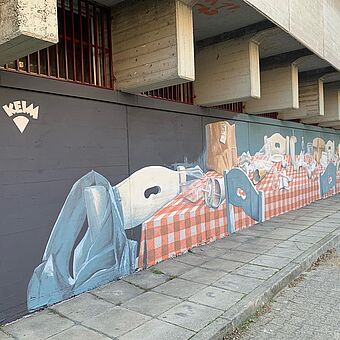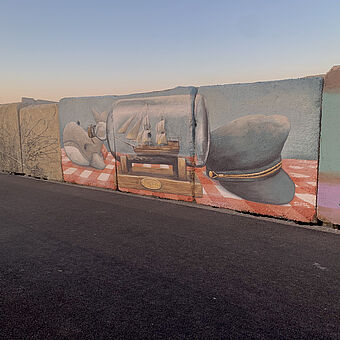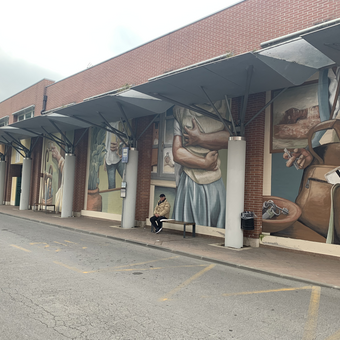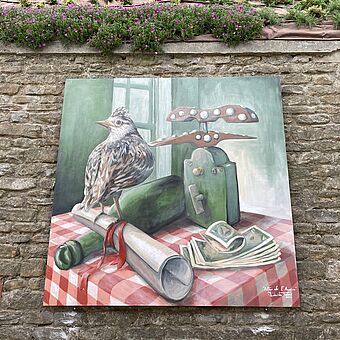Interview with Davide Tolasi
The internationally recognised street artist Davide Tolasi (Instagram: @davide_tolasi) from Italy raises awareness for environmental and climate protection with his 1200 square metre artwork in Cremona. With KEIM Soldalit-ME, the artist chose a mineral paint with a photocatalytic effect that reduces the concentration of pollutants in the air thanks to its chemical and physical properties. In the meantime, the mural with its 400 metres length and a height of 2.5 metres is the largest smog-reducing mural in Europe. All the paints were donated by the Italian subsidiary KEIMFARBEN Colori Minerali S.R.L.. In the interview, he lets us share his ideas and projects.
How did you come to your current profession?
I got into painting at a very early age, mainly thanks to my maternal grandmother who was always involved in painting. As a teenager, I was fascinated by the graffiti movement, but it was only during my studies at the academy that I could really see it - that was then the beginning of my artistic research. I was part of an art collective for a few years, with whom I created very large murals in different places in Italy and Europe. Then I decided to separate and concentrate on my personal research.
What is the process of preparing a project? How long does a project take on average?
Actually there is no standard process, rather it depends very much on the context and on what I will implement. I almost always start by thinking about the conceptual aspects I want to represent. In this context, I am looking for information and inputs from various art forms that stimulate my creative phase. Then I start my creative phase, studying the environment and the colors and shapes of the landscape where the project is to be implemented. The final phase is to bring together the rational aspect (i.e. analysis) and the conceptual aspect to give shape to the project. The duration varies greatly and of course depends on the complexity and scope of the work to be realized. Lately, I prefer small commissions because in them I can find a very intimate aspect of painting that fascinates me. But I have also realized large projects that I have worked on for several months.
What are the greatest difficulties?
An infinite number! Every construction site has different problems starting from technical problems to the wall you have to paint on to the weather. It never gets boring!
Some of his artworks




What has been your biggest and/or best project so far?
When I am invited to schools to talk about my work and the children ask me this question, I always tell them what I will do tomorrow. Because I believe that, as with everything, also in this discipline, there is a development for the better from time to time. In any case, I am very proud of "Incipit", the last work I did for the Soncino bus station, although I think that the painting "Concordia" is unbeatable when it comes to size, since it is a painting of 1085 square metres.
What was the absolute biggest challenge? Are there times when you sometimes wish you had a different job?
From a technical point of view, the Concordia project was very challenging for both me and the two other artists I worked with in terms of design and implementation. It was an endless space: we cycled from one place to another on the site. And very complex because it was a boundary wall, parts of which were made of other prefabricated reinforced concrete - so it didn't have a perfectly smooth surface. But in the first years that I was a professional painter in Italy, it was certainly a big "social" challenge, because at that time street art was not as well known as it is today. Especially in the centre of Milan, it was not only necessary to create this work, but also to try to eliminate the stereotypical mural painting in terms of "vandalism and destruction". Although a little more than a decade has passed today, it is certainly easier and the inhabitants appreciate these interventions very much because they have understood the value they give to the city. In any case, I never thought of doing any other work, apart from wasting time on a thousand bureaucratic and institutional matters, in order to carry out a job.
What kind of feeling do you have when a work of art is completed?
I haven't experienced that feeling yet, but I think it's kind of like raising a child, seeing it through to maturity and then allowing it to go its own way. It's a very strange feeling, certainly very liberating, but also very formative, especially with big projects, where the wall and the building site become a little bit your home, you get used to the rhythm of that environment, to the people who come by every day to look at the work. Then comes the moment when everything has to be dismantled because the work is finished, and with a little nostalgia you physically leave this place, leaving only the artwork as a trace of your presence and taking this experience with you.
What would be your dream project if you could choose it?
I have always had a big dream, which is to completely paint a church. I was raised religious and have a special passion for the holy figures and stories told on the walls and canvases of these sacred places. It would be a wonderful challenge to design and execute a project of this nature with maximum creative freedom.
What do you like most about your work?
Can I answer everything? Indeed, it is always varied and balanced, and that always allows me to find a dimension in which I feel comfortable: it allows me to have constant contact with so many different people, but also to isolate myself and find intimacy. I have to let off steam creatively, but also keep my feet on the ground and think about the feasibility of the project.
"If we don't leave a future, we have lived in vain". This is the powerful message on the 1200 square metre mural in Cremona, which was inaugurated on 6 November 2021.
Why did you choose our colours?
First of all, the quality of the products, which guarantees a long life, but also a unique aesthetic; then, of course, the environmentally friendly aspect is important, especially in this day and age.
What is your favourite KEIM product?
I would say Soldalit, because it really is an enormously versatile and reliable product in any application, from flat colours to more complex shades and glazes.
